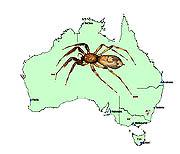 The project entails preparing monographs covering the Australian ground spiders of the superfamily Gnaphosoidea. These spiders are among the most abundant and important predators in both forest and drier habitats throughout Australia, Tasmania, New Caledonia and New Zealand. Their systematics is nevertheless extremely poorly known. The limits of the superfamily, and at least some of the seven currently recognized families in the group are likely to change significantly as a result of this work. Although the members of the five families known to occur in Australasia (the Lamponidae, Gallieniellidae, Trochanteriidae, Prodidomidae, and Gnaphosidae) do not form a single monophyletic group, they are almost completely endemic to Australasia, comprise relatively few monophyletic groups, and together pose the most severe test of the currently accepted familial classification.
The project entails preparing monographs covering the Australian ground spiders of the superfamily Gnaphosoidea. These spiders are among the most abundant and important predators in both forest and drier habitats throughout Australia, Tasmania, New Caledonia and New Zealand. Their systematics is nevertheless extremely poorly known. The limits of the superfamily, and at least some of the seven currently recognized families in the group are likely to change significantly as a result of this work. Although the members of the five families known to occur in Australasia (the Lamponidae, Gallieniellidae, Trochanteriidae, Prodidomidae, and Gnaphosidae) do not form a single monophyletic group, they are almost completely endemic to Australasia, comprise relatively few monophyletic groups, and together pose the most severe test of the currently accepted familial classification.
Because the project will cover an estimated 650 species, completion of the work should provide a wealth of information on the identity and interrelationships of areas of endemism within Australia, and thus greatly test and supplement the relatively few biogeographic generalizations currently available for the region, which have been largely based on bird and eucalypt distributions. These ground spiders, which typically have relatively small distribution ranges, should greatly increase the resolution of such generalizations, to the benefit of both biogeographers and land managers.
This project is being supported by a PEET (Partnerships for Enhancing Expertise in Taxonomy) award from the National Science Foundation, and also by the Australian Biological Resources Study, Canberra.